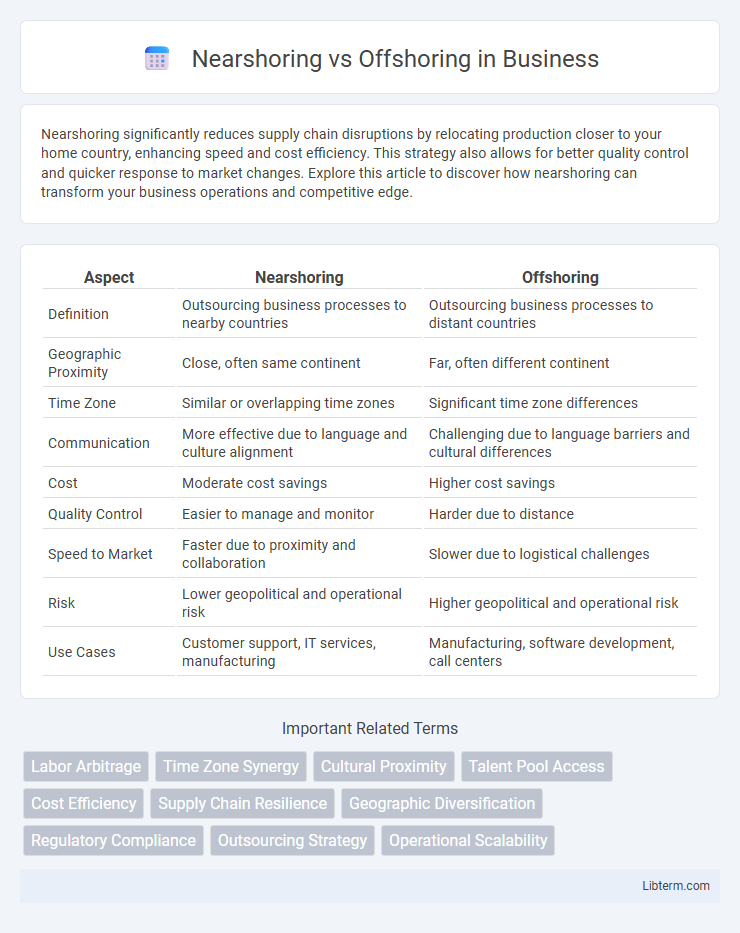Nearshoring significantly reduces supply chain disruptions by relocating production closer to your home country, enhancing speed and cost efficiency. This strategy also allows for better quality control and quicker response to market changes. Explore this article to discover how nearshoring can transform your business operations and competitive edge.
Table of Comparison
| Aspect | Nearshoring | Offshoring |
|---|---|---|
| Definition | Outsourcing business processes to nearby countries | Outsourcing business processes to distant countries |
| Geographic Proximity | Close, often same continent | Far, often different continent |
| Time Zone | Similar or overlapping time zones | Significant time zone differences |
| Communication | More effective due to language and culture alignment | Challenging due to language barriers and cultural differences |
| Cost | Moderate cost savings | Higher cost savings |
| Quality Control | Easier to manage and monitor | Harder due to distance |
| Speed to Market | Faster due to proximity and collaboration | Slower due to logistical challenges |
| Risk | Lower geopolitical and operational risk | Higher geopolitical and operational risk |
| Use Cases | Customer support, IT services, manufacturing | Manufacturing, software development, call centers |
Introduction to Nearshoring and Offshoring
Nearshoring involves relocating business processes or production to nearby countries, often to reduce costs while maintaining closer geographical and cultural proximity. Offshoring refers to transferring operations to distant countries with lower labor costs, frequently resulting in greater savings but increased challenges in communication and time zones. Both strategies aim to optimize operational efficiency but differ significantly in terms of risk, cost, and logistical complexity.
Key Differences Between Nearshoring and Offshoring
Nearshoring involves relocating business processes to nearby countries, often within the same continent, enhancing communication and reducing time zone challenges compared to offshoring, which delegates tasks to distant, often overseas locations to capitalize on lower labor costs. Nearshoring typically offers faster turnaround times and easier cultural alignment, while offshoring emphasizes significant cost savings through access to cheaper labor markets in countries like India or the Philippines. Risk management also differs; nearshoring reduces geopolitical risks and supply chain uncertainties common in offshoring, making it a strategically viable option for businesses seeking balance between cost efficiency and operational control.
Pros and Cons of Nearshoring
Nearshoring offers advantages such as reduced shipping costs, faster delivery times, and easier communication due to geographic and time zone proximity. It enhances supply chain flexibility and risk management by allowing quicker responses to market changes and disruptions. However, nearshoring may involve higher labor costs compared to offshoring in low-wage countries, and there may be limitations in available skill sets or manufacturing capabilities within nearby regions.
Pros and Cons of Offshoring
Offshoring offers cost savings through lower labor expenses and access to skilled talent pools in countries like India and the Philippines, boosting operational efficiency for companies. However, it presents challenges such as language barriers, cultural differences, and time zone misalignment that can hinder communication and project management. Risks also include data security concerns, potential quality control issues, and geopolitical instability affecting business continuity.
Cost Comparison: Nearshoring vs Offshoring
Nearshoring typically reduces labor and logistics costs compared to offshoring due to closer geographic proximity and time zone alignment. Companies benefit from lower shipping expenses and faster turnaround times, which offset slightly higher labor rates in nearshore locations versus offshore destinations with cheaper wages but increased overhead. Total cost evaluation often favors nearshoring for businesses prioritizing agility and reduced supply chain risks despite the initial higher hourly labor costs.
Impact on Communication and Collaboration
Nearshoring enhances communication and collaboration by minimizing time zone differences and cultural barriers, leading to more real-time interactions and clearer understanding between teams. Offshoring often faces challenges such as delayed responses and misinterpretations due to larger time zone gaps and language nuances. Companies prioritizing agile project management and continuous feedback loops tend to benefit more significantly from nearshoring's streamlined communication channels.
Cultural and Time Zone Considerations
Nearshoring offers significant advantages in cultural alignment and time zone compatibility, facilitating smoother communication and faster decision-making compared to offshoring. Companies nearshoring to countries within similar time zones benefit from overlapping working hours, reducing delays common in offshoring to distant regions. Cultural proximity in nearshoring also minimizes misunderstandings and enhances collaboration, making project management more efficient.
Talent Availability and Skill Set Differences
Nearshoring offers access to a workforce with similar time zones and cultural alignment, often providing skilled professionals experienced in emerging technologies and agile methodologies. Offshoring typically focuses on cost efficiency but may encounter challenges in talent availability with specialized skill sets, leading to potential gaps in project execution. Companies prioritizing rapid innovation and collaboration often favor nearshoring for richer talent pools and enhanced communication capabilities.
Security, Compliance, and Data Privacy
Nearshoring offers enhanced security and compliance benefits by situating operations closer to domestic regulatory environments, ensuring adherence to strict data privacy laws such as GDPR and CCPA. Offshoring often presents challenges in maintaining consistent security protocols and aligning with diverse international data protection standards, increasing the risk of data breaches and regulatory non-compliance. Companies prioritizing secure data handling and regulatory compliance increasingly prefer nearshoring to mitigate risks associated with cross-border data transfers and cyber threats.
Choosing the Right Model for Your Business
Selecting the right model between nearshoring and offshoring hinges on factors such as cost efficiency, cultural compatibility, and time zone alignment. Nearshoring offers closer geographical proximity, enabling faster communication and reduced travel expenses, making it ideal for businesses prioritizing agility and collaboration. Offshoring provides significant labor cost savings by leveraging distant, lower-wage markets but may pose challenges in managing language barriers and extended delivery timelines.
Nearshoring Infographic

 libterm.com
libterm.com